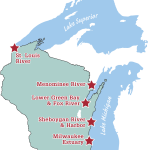 MEDIA CONTACT: Peter Cassell (EPA), 312-886-6234, 312-859-9614 (Cell), cassell.peter@epa.gov.
MEDIA CONTACT: Peter Cassell (EPA), 312-886-6234, 312-859-9614 (Cell), cassell.peter@epa.gov.
For Immediate Release No. 13-OPA043
EPA Announces First 2013 Great Lakes Restoration Initiative Grant and Priorities at Great Lakes Week
MILWAUKEE (Sept. 11, 2013) – U.S. Environmental Protection Agency Deputy Administrator Bob Perciasepe today announced a new 2013 Great Lakes Restoration Initiative grant at Great Lakes Week in Milwaukee. The Wisconsin Department of Natural Resources will receive more than $1.5 million for several Milwaukee Estuary and Great Lakes projects.
“The Great Lakes are critical to our economy and support millions of American jobs,” Perciasepe said. “These investments build upon the progress we’ve already made to clean up the Great Lakes and all of our country’s cherished waters.”
“It is because of the Great Lakes Restoration Initiative that we can continue to make real progress in addressing Great Lakes issues today for the benefit of future Wisconsinites,” affirmed Ken Johnson, Administrator for the Wisconsin Department of Natural Resources’ Office of Water. “This grant for the Milwaukee Estuary Area of Concern again demonstrates what can be accomplished through federal-state-local partnerships to make progress toward delisting this AOC.”
The grant announced today will be used to:
- Inventory fish and wildlife populations in the Milwaukee area.
- Locate uncontrolled sources of sewage and evaluate their impacts on water quality.
- Restore and expand grassland habitat in the area and increase breeding opportunities for threatened grassland species.
- Assess the health of microscopic aquatic communities and of bottom-dwelling organisms in four Wisconsin AOCs, including the Milwaukee Estuary.
Many of these activities are necessary to restore beneficial uses so the Milwaukee Estuary AOC can be taken off the cleanup list. The Milwaukee Estuary AOC is one of 29 highly contaminated hotspots on the U.S. side of the Great Lakes border or shared with Canada.
Deputy Administrator Perciasepe also announced the Great Lakes federal Interagency Task Force priorities for fiscal year 2015 to help states, municipalities, tribes, business interests, environmental groups, the academic community and other partners plan their activities. On behalf of the federal agencies that met in Milwaukee today, he announced:
- Progress in developing the next GLRI Action Plan, covering fiscal years 2015-2019. The IATF has spent the past several months seeking input to inform the development of a draft FY15-19 Action Plan, which will be released for public comment in early 2014.
- In fiscal year 2015, the GLRI will likely continue with an emphasis on five focus areas (Toxics, Habitat, Nearshore Health, Invasive Species and Accountability) and within these three priorities:
* Accelerating the cleanup of AOCs such as Milwaukee Estuary.
* Preventing invasive species, such as Asian carp, from becoming established in the Great Lakes.
* Reducing runoff that causes harmful algal blooms in three priority watersheds – Wisconsin’s Lower Fox River/Green Bay, Ohio’s Maumee River and Michigan’s Saginaw River.
- The next Action Plan will also emphasize the need to ensure that GLRI projects are not undermined because of changing weather patterns, in addition to many other needs raised by the Great Lakes community.
The IATF is made up of 11 federal departments and is tasked with overseeing management of the GLRI, which President Obama proposed and a bipartisan Congress has continued to fund. For more information about the Great Lakes Restoration Initiative, visit http://www.glri.us/.



